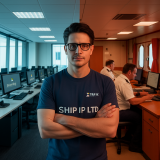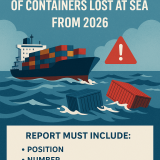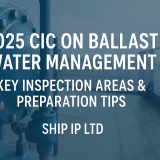Over the last few months, the topic of smart shipping and the various purposes of maritime IoT has been receiving increased media attention. A key point to remember is these terms mean different things to different people within the shipping ecosystem, writes Joshua Flood, senior research consultant at Valour Consultancy.
I will attempt to shed some light upon these….the uses of smart shipping technology for a shipowner, to a charterer, a ship manager, or an operator will vary significantly. One is primarily maintaining the asset’s value and utilisation as best as possible, another may to simply enable the vessel to reach its destination as quick and cost effectively, or another to maintain optimal performance of vessel operations.
Companies providing solutions will vary in their approach to each segment and how they convey their solutions. Software control of major marine equipment has been with us for over 30 years and with the capacity of microchips and memory increasing so has the sophistication and proliferation of that control so much so that, beyond the galley kitchen, it is rare to find some aspect or equipment of modern ships that is not monitored and/or controlled by a microprocessor. Connecting these to a shore-based intelligence (artificial or otherwise) is a sensible step.
Within maritime digital application vendors, the race is wide open, and how companies target potential customer group differs. One notable observation, from myself, is that everyone seems to be focused on the merchant market and the time to build up a critical mass of dominance in this area will lengthy.
Solutions within the maritime connectivity service provider market are also building and we are seeing some clear frontrunners, particularly Inmarsat and KVH Industries.
However, what some people may not realise is the strength, and clever strategies deployed by marine OEMs. In this piece, I wanted to give a clear overview of the key players in this part of the ecosystem.
In the case of marine OEMs, these firms have quickly envisage the potential for connected vessels with new operations of innovation or cost savings, and adjusted their businesses accordingly.
This has been a case from moving CAPEX business models for machinery to SaaS model for value added services or service included within the purchase of equipment.
This means the owners of the connectivity solution onboard the vessel need to allocate or allow some capacity for equipment machineries.
Recently, I interviewed Wärtsilä in regards to Fleet Operations Solution for voyage planning and fleet performance management.
The firm offers an entry point to an element of its smart shipping service with Navi-Planner which incorporates a modular approach; the first being “tracking and awareness”. In some cases, no upfront payments are required for installing a module onboard. Obviously to fully utilise the Warstila’s smart shipping solutions, radar and bridge sensors are necessary.
The primary object of the tool is allow an operator or charterer to understand their fleets in real-time, see planned routes, contingent deviations and forecast vessel/fleet schedules. Connectivity is key and VSAT, and even MSS connectivity needs sufficient bandwidth for use. Interestingly, Wärtsilä is offering customers the connectivity capabilities (like a service provider) as part of its fleet operation solutions, however, how many vessels they’ve equipped as a service provider is unknown. My guess is less than 500 but more than 100. (However, I should add this is only a portion of Wärtsilä’s smart shipping portfolio, and customers brought from the Eniram acquisition, vessel traffic services and others means Wärtsilä has a hefty number of vessel subscriptions.)
Monthly fees for Navi-Planner increase with additional modules of compliance reporting, voyage and ports and also hull-monitoring and engine supervision are included. The compliance and reporting module is particularly useful for charterers, hull and engine module for ship owners to extoll the productivity of their asset and voyage and ports solution for any companies looking to augment their logistics capabilities.
While Wärtsilä has been pushing focused services of a vessel’s functionality, ABB, with its ABB Ability solution has been gathering pace. In another interview with Antto Shemeikka, Vice President Digital Services, ABB Marine & Ports, the division of ABB. He referred to the firm advancing its remote diagnostics capabilities significantly over the last 18 months. The practicality of this feature during the ongoing pandemic has highlighted tenfold and places great value upon the solution.
Moreover, ABB also launched its Genix Industrial Analytics and AI suite to aid in decision making. Within Abilities, the firm believes Genix has the potential to help its customers save up to 10 percent fuel, cutting costs and reducing emissions. A good example is a vessel consumes 50 tons of fuel per day. By deploying this solution, the vessel operator can save 5 tons of fuel per day, probably cutting overall operating costs by a similar portion. To boost matters further, over a ten day period, the operator will cut 50 tons of CO2 emissions.
Additionally, maintenance savings utilising condition-based monitoring and early identification of potential malfunctions improve vessel uptime and reduce essential service visits to vessels by as much as 30 percent, Antto informed me.
ABB has refrained from getting too involved in whether the vessel has connectivity, and providing this if not. It is unclear why the company has chosen not to get too involved in this area as connectivity is vital for its solutions. Valour’s take is in the case of Wärtsilä, that decision was probably thrust upon them. Wärtsilä has a significant market in after-sales. Its primary products aregreat big heavy marine diesel engines which need regular overhauls. Most ships won’t have the crew numbers for this activity so will call in a Wärtsilä team or one of the licensed providers to strip the engines. Many of these ships are older models and, in order to increase that side of their business, they will have offered extended warranty provided the ship engines can report into a Wärtsilä base, so it was in their commercial interest to hook up with a connectivity supplier. ABB are electrical and electronic so after-sales is a minimal part of their business. Distribution and control systems are rarely overhauled.
Nevertheless, this has not stopped ABB from introducing new services such as the OCTOPUS suite. Initially, introduced for ROV (surface and aerial) in the offshore wind sector, a project named ALTANTIS, to reduce working times on site and consequently vessel waiting time. This is particularly useful during rough sea conditions or other adverse weather conditions.
The application of this service can be used for cruise vendors to help avoid excessively rough weather or in the offshore oil and gas industry for rigs and floating offshore units, also while carrying out heavy lifts offshore. Indeed, OCTOPUS is also be being used for container vessels in regards to wave forecasts and looking to minimise accelerations at container locations. In short, the service anticipates the forecast wave movements and automatically places cargo in the best positions and loads across the vessel to deal with the predicted waves during the voyage. In the case of a container, or many, falling off (the WSC estimates that there were on average a total of 1,382 containers lost at sea each year) or cargo being damaged, the costs can be high.
This technology can also be applied for real time decision whilst making for heavy lifts or during voyages and operations to increase effectiveness and safety of those operations. ABB estimates that the system is currently utilised by around 90 per cent of the semi-submersible heavy lift ships in operation worldwide.
By the end of 2021, Valour Consultancy anticipates more than 60,000 smart shipping subscriptions will be sold by marine OEMs, representing a hefty chunk of changes, nearly $235 million globally. More increasingly, we foresee monthly subscription rates increasing over the next two to three years.
https://thedigitalship.com/news/maritime-software/item/7387-evolution-of-maritime-smart-shipping-strategies














